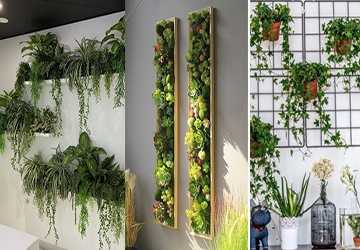In the ever-evolving landscape of urban settings, gardens have transformed from sprawling backyards to compact vertical spaces. As cities grow denser, the emphasis on upward rather than outward expansion becomes clear. Herein lies the beauty and utility of vertical gardens. This vertical garden guide will walk you through top techniques, shedding light on space-saving plants and vital urban gardening techniques.
Understanding Vertical Gardening
Vertical gardening isn't just planting upwards; it's an art. It's about maximizing limited space to cultivate plants, often combining aesthetics with functionality. But how does one start? This vertical garden guide is here to help.

Critical Techniques for Successful Vertical Gardening
1. Trellises and Climbing Supports:
One of the most traditional urban gardening techniques is using trellises. They are frameworks that allow plants, especially climbers like beans, peas, and some flowering vines, to grow upwards. They not only serve a functional role but can also be decorative.
2. Wall-mounted Pots:
These are fantastic space-saving plant options. From simple pot hangers to more intricate designs, wall-mounted pots can turn any blank wall into a green oasis.
3. Pallet Gardening:
Repurposed wooden pallets can be transformed into vertical gardens. This technique is not just eco-friendly but also cost-effective. Ensure proper waterproofing and soil retention strategies when using this method.
4. Hanging Planters:
Suspended from ceilings or balconies, hanging planters can house various plants. They're perfect for herbs or smaller plants that require less soil depth.
5. Vertical Planter Stands:
Multi-layered stands are available in various designs. They allow pots to be placed at different levels, ensuring each plant receives adequate sunlight.
6. Green Walls or Living Walls:
A more advanced form of vertical gardening, living walls are where the wall itself becomes a medium for plants to grow. Incorporating an irrigation system and proper plant selection can result in a breathtaking green fence.
7. Geo-textile Pockets:
Fabric pockets can be attached to walls or frames, allowing for proper water drainage and root aeration.
8. Mesh and Netting:
Lightweight and sturdy, they are perfect for climbing vegetables and fruits. They not only provide support but also guide plant growth vertically.
9. Freestanding Vertical Panels:
Independent panels with built-in slots for plants. They're movable, allowing for flexibility in design and sunlight exposure.
10. Aeroponic Towers:
A soilless system where plants grow with the aid of misted nutrients. It's a futuristic approach to vertical gardening, conserving water and space.
Choosing the Right Space-Saving Plants
Your vertical garden's success largely hinges on the plants you select. Some plants naturally lend themselves to vertical growth, making them ideal space-saving plants:
● Climbing Plants: Ivy, Morning Glory, and Clematis are prime examples. Their natural tendency to climb makes them fit seamlessly into vertical gardens.
● Succulents: Their low maintenance nature and compact growth habit make succulents a top choice. They are especially suited for wall-mounted pots and pallet gardens.
● Herbs: Basil, mint, and rosemary love growing vertically. Their shallow roots make them perfect for hanging planters.
● Edible Plants: Strawberries, tomatoes, and certain types of beans and peas can be trained to grow vertically, maximizing yield in limited spaces.
The Impact of Vertical Gardens in Urban Settings
Beyond the aesthetic value, vertical gardens significantly impact urban environments:
● Temperature Regulation: Green walls can provide insulation, saving energy.
● Air Quality Improvement: Plants naturally filter and purify air, making vertical gardens a boon in polluted urban areas.
● Biodiversity: Vertical gardens can attract beneficial insects, promoting biodiversity even in the heart of cities.
Innovative Vertical Garden Designs
Creativity soars as vertical gardening takes root in modern architectural and landscaping designs. Here are some innovative designs:
● Modular Systems: These systems allow gardeners to add or remove sections based on their needs. It is ideal for those who frequently change their garden's look.
● Vertical Garden Frames: Much like a photo frame but larger and filled with plants. They can be standalone features or mounted on walls.
● Gutter Gardens: Repurposing old gutters into plant containers is sustainable and chic. Ensure they have adequate drainage.
● Shoe Organizer Gardens: Over-the-door shoe organizers are excellent for growing herbs or small plants. They offer the advantage of individual pockets for different plants, ensuring roots don't get entangled.

Benefits of Vertical Gardens for Urban Dwellers
The urban environment, often dominated by concrete, can be transformed with vertical gardens. Here's why they're a boon:
● Space Maximization: For apartment dwellers or those with limited ground space, growing vertically provides an opportunity to have a garden.
● Privacy: A green wall can be a natural screen, providing privacy from neighboring balconies or windows.
● Mental Wellbeing: The therapeutic benefits of gardening combined with the visual appeal of a vertical garden can reduce stress and increase overall wellbeing.
Challenges in Vertical Gardening and Solutions
While the vertical garden guide highlights many advantages, there are challenges to acknowledge:
● Weight Concerns: Especially for balcony gardeners, the weight of planters, soil, and water can be a concern. Ensure the structure's stability and consider lightweight potting mixes.
● Irrigation Issues: Overwatering one plant might result in the one below getting drenched. Drip irrigation or self-watering containers can help manage this.
● Light Distribution: Plants at the bottom might be overshadowed by those above. Rotate plants regularly or use grow lights to ensure even light distribution.
The Future of Vertical Gardens
As urban areas continue to grow and space becomes a premium, the integration of green spaces becomes crucial. Vertical gardens are not just a trend but a glimpse into the future of urban landscapes. Innovations in urban gardening techniques will lead to more sustainable, efficient, and visually appealing vertical gardens, making our cities greener and more vibrant.
The Role of Technology in Vertical Gardening
With advancements in tech, vertical gardening is evolving rapidly. Intelligent sensors now monitor soil moisture and nutrient levels, ensuring plants get optimal care. Apps provide timely urban gardening techniques and reminders, revolutionizing how we approach these space-saving plants and making green spaces more accessible.
Conclusion
With the guidance of this vertical garden guide, anyone can embark on the journey of vertical gardening. You can transform any urban space into a green haven by employing the proper urban gardening techniques and selecting the perfect space-saving plants. Vertical gardens stand as a testament to human ingenuity and nature's adaptability as urban landscapes continue to evolve.


